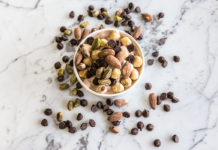Ingrown hairs are hairs that do not grow properly, but do so under the skin, often causing discomfort, irritation and inflammation in the affected area. These occur frequently after shaving or depilation of some areas of the body and although most of the time they do not cause major complications, it may be the case that said cystic hair becomes infected due to the colonization of the bacteria that are present in the surface of the skin and, consequently, a red, very inflamed pimple or lump appears, even full of pus. In the following article of a COMO, we explain in detail what to do in this situation and how to cure a properly infected ingrown hair to avoid further complications. Pay attention!

Causes and symptoms of ingrown hairs
The ingrown hairs are hairs do not grow outward, but grow under the skin sideways because hair follicles are clogged by dead skin cells.
Among the main causes of cystic hairs are hair removal, so they usually appear in the areas of the body that we shave or shave. In the case of men, they are more frequent in the area of the beard and the testicles and, in the case of women, in the legs, armpits, abdomen and pubes. Some of the factors that can favor the hairs to be incarnated are the following:
- A hair that is very curly, since this type of hair favors that the hair enters the skin again after being cut and begins to grow again.
- Shave dry hair.
- Stretch and tighten the skin during shaving, which can cause the hair to retract towards the skin by re-entering it without first growing outward.
- Hair removal with tweezers.
Both electric epilators and blades favor the formation of cystic hairs, the best method of hair removal to prevent them is wax. When a hair is incarnated, the body detects it as if it were a foreign body and, before it, an inflammation is generated around it, which can also cause pain, redness, small bumps and infection.
The main symptoms of ingrown hairs are the following:
- Firm and round small bumps or papules.
- Pustules or small skin lesions with pus very similar to blisters.
- Darkened skin.
- Redness
- Hair or hair trapped under the skin.
Incarnate infected hair: symptoms
One of the most frequent complications of ingrown hairs is that a bacterial infection occurs and the hair follicle is infected, usually, by staphylococcus bacteria, which usually enter the subcutaneous tissue through small wounds in the area, either by scratching, cuts or small breaks of the skin. When this occurs, in order to fight the infection, neutrophils (the most common type of white blood cells) travel to the area and inflammation and the formation of a pocket of pus under the skin, called a boil, is generated.
The main symptoms of a boil and that can indicate that an ingrown hair is infected are the ones listed below:
- Appearance of a subcutaneous, red and painful bulge that increases in size as the days fill with pus and dead cells. Finally, a white or yellowish point will appear in the center of that bulge.
- Redness
- Pain and discomfort in the area of the boil and around it.
Normally, when all the pus is drained outwards, the pain and discomfort disappear and this skin lesion heals without leaving scars in the area, except for those boils that are of a considerable size and have a great depth.
How to get an infected ingrown hair
In many cases, ingrown hairs do not require specific treatment and end up coming out on their own. Now, when we show signs of infection and ingrown hair is deep, it is important to see a doctor and not treat the problem at home or self-medicate.
The medical treatment to cure infected cystic hair will depend in each case on the degree of infection and the symptoms that the patient presents but, in general, it can consist of the following:
- Application of wet compresses with warm waterfor 10 or 20 minutes about three times a day to reduce inflammation and facilitate drainage of pus and healing of ingrown hair.
- Drugs Antibiotics: in cases of mild infection, the doctor will prescribe the application of a lotion containing antibiotics to fight the bacteria responsible for the infection. Only in those cases of severe infection, oral antibiotics will be prescribed.
- Creams to reduce inflammation of the skin: steroid creamsmay help to reduce swelling and itching of the affected area.
- Minor surgery:in those cases where the boil does not drain spontaneously after a few days, a small incision can be made in the area to drain all the accumulated pus, remove deep ingrown hair and accelerate its healing.
In addition to the above, it is important to take into account some care and measures such as the following:
- Keep the area of ingrown hair clean and dry. Cleaning should be done with neutral soap and warm water.
- Do not squeeze or burst the bump.
- Do not apply topical medications or other people’s lotions.
- Wash your hands very well before and after touching the affected area.
Home remedies for ingrown hairs
There are some natural remedies that can be of great help in the process of curing an infected ingrown hair, especially to reduce pain and discomfort in the affected area. However, they should not replace medical treatment in any case.
Chamomile Compresses
Chamomile has anti-inflammatory and antibacterial properties that can help heal an infected ingrown hair more quickly.
- Prepare an infusion of chamomile.
- When it is warm, soak a gauze in it.
- Place the gauze over the skin lesion, letting it sit for 10 minutes.
Oats
Oatmeal can serve you to make baths that provide you with great relief, heal the skin, repair and deflate it effectively, as it is a cereal with soothing, anti-inflammatory and moisturizing properties.
- In a pot, boil about 500 grams of oatmeal for about 5 minutes.
- After that time, remove from heat and beat the mixture.
- Add the mixture to the warm water of the bathtub.
- Take a relaxing bath for about 20 minutes, submerging the area affected by cystic hair.
Tea tree oil
This oil is a good natural antibiotic and antiseptic, being excellent for combating bacterial infection and relieving the discomfort that infected ingrown hair can cause.
- Dilute about 4 drops of tea tree oil in 1/2 cup of water.
- Apply the resulting liquid over the damaged area.
- Wait for the oil to dry on its own.










